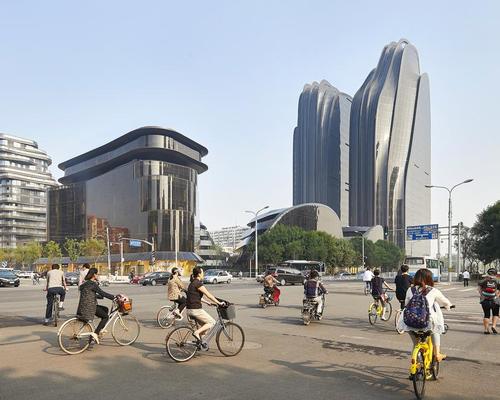05 Dec 2017
MAD Architects move mountains for vast nature-inspired Chaoyang Park Plaza in Beijing
BY Kim Megson

Chinese practice MAD Architects have completed their latest urban-scale “expansion of nature” – a vast residential, commercial and leisure complex in Beijing that brings mountainous man-made towers into the heart of the city.
The 220,000sq m (2.3 million sq ft) Chaoyang Park Plaza is formed of 10 organically shaped buildings, each with smooth curved surfaces of black and white. It was conceived as an extension of the park – the largest in the central business district area – into the city itself.
MAD’s design seeks to conceptually ‘borrow’ brooks, creeks, rocks, valleys and forests from a distant landscape. Two asymmetrical twin tower office buildings on the north side of the site sit at the base of the park’s lake and evoke a pair of mountain peaks growing up to 142m (465.8ft) out of the water, with a transparent atrium pulling them together with a connecting glass rooftop structure.
The small-scale, low-rise commercial buildings have been designed to appear like mountain rocks that have endured long-term erosion. Their strategic relationship to one another forms “a secluded, but open urban garden” where people can meet within nature in the middle of the city.
Ma Yansong, the founder of MAD, said his ambition was “to create a different kind of city that, on a spiritual and cultural level, can be compared to the classical cities of Eastern philosophy and wisdom”.
“In modern cities, architecture as an artificial creation is seen more as a symbol of capital, power or technological development, while nature exists independently,” he said.
“It’s different from traditional Eastern cities where architecture and nature are designed as a whole, creating an atmosphere that serves to fulfil one’s spiritual pursuits.
“We want to blur the boundary between nature and the artificial, and make it so that both are designed with the other in mind. Then, the argument in the modern logic of humans to protect or to destroy nature will no longer exist if we understand and see humans and nature as co-existing.
"Human behaviour and emotion is part of nature, and nature is where that originates and ends.”
The project has been awarded LEED Gold Certification by the US Green Building Council for its sustainable features, including vertical fins on the towers that function as an energy-efficient ventilation and filtration system, drawing fresh air indoors.
The project, which took five years, was funded by Smart-hero (HK) Investment Development Limited. Other design firms collaborating with MAD included executive architects CCDI Group, façade consultants RFR Asia, interior designers MADA s.p.a.m. and the Greentown Akin Landscape Architecture Company.
MAD are currently working on a number of high-profile projects that similarly merge the artificial with the natural, including a museum for George Lucas in Los Angeles, a concert hall in Beijing and a series of interlinked green parks and leisure communities in place of Milan’s abandoned and dilapidated railyards.
Yansong has previously told CLADglobal that conservatism should not be allowed to stifle the creation of beautiful and boundary-pushing buildings, adding that creating a dialogue with the natural world must now “be the main focus” for architects.
“‘Nature’ in my sense of the word is a cultural thing – it’s more than just thinking about green architecture and sustainability,” he said. “Instead it has a more spiritual and poetic meaning.
"I’m talking about referencing nature even if there are no trees and there is no grass – and at the current stage, I’m actually trying to not put many trees in my buildings. Instead, it’s all about the space. What can you see? How does it make you feel? How does the architecture itself make the urban skyline more nature-like?
“We can learn from nature and then move beyond it. If you look at the ocean, it’s beautiful. But if you live by the ocean you will get tired of it eventually. We have the ability to be inspired by nature, but then create something a little bit different.”
Close Window